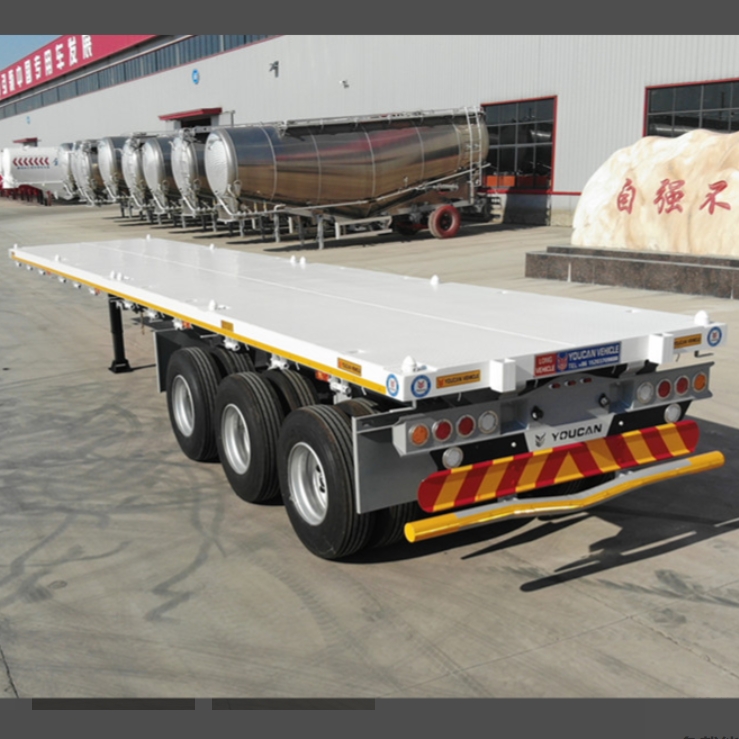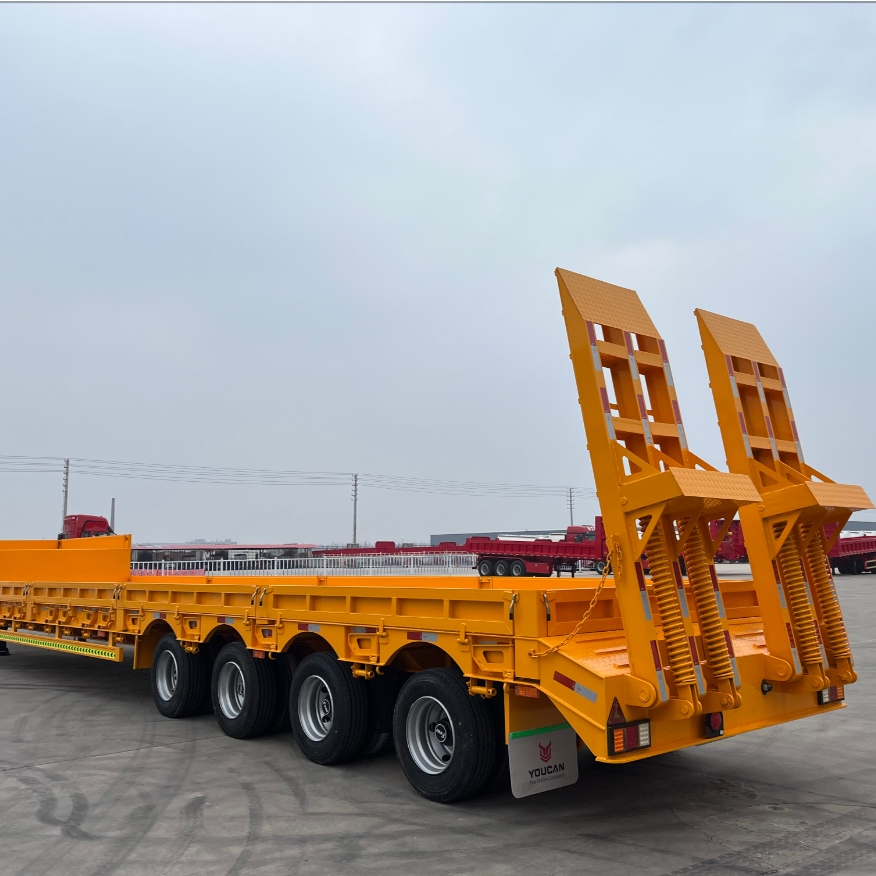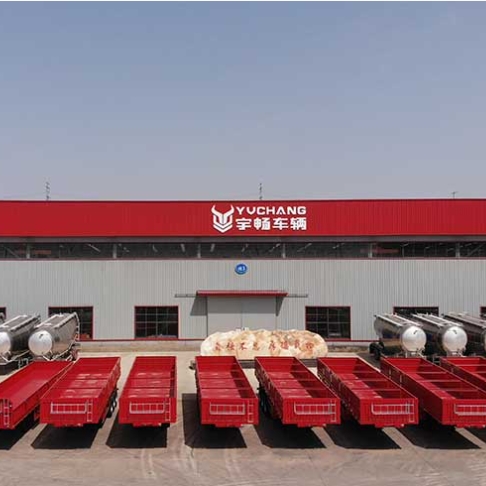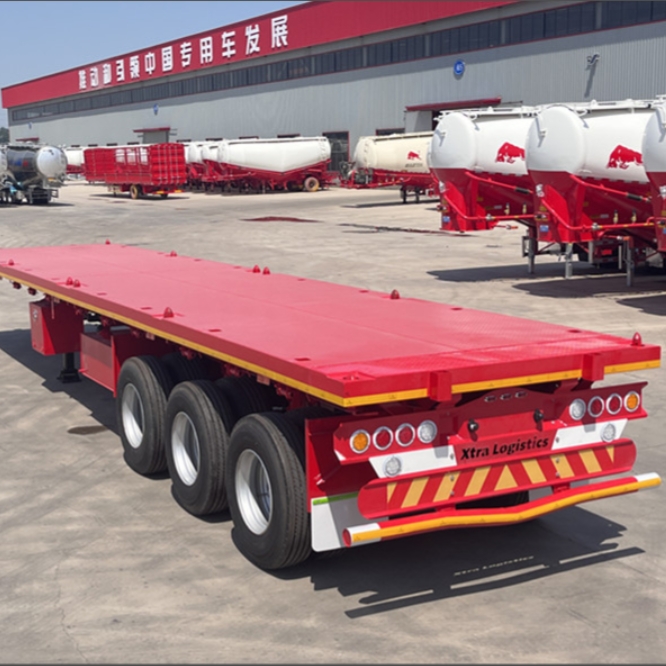Flatbed Trailers VS Lowbed Trailers:Choosing the Right Trailer for Your Cargo
Introduction When it comes to transporting cargo, the proper selection of a trailer is crucial for ensuring safety, efficiency, and compliance with transportation regulations. Two popular types of trailers used in various industries are flatbed and lowbed trailers. In this article, we'll explore their features, advantages, and disadvantages to help you determine the most suitable option for your cargo transportation needs.
Flatbed Trailers
What is a Flatbed Trailer?
A flatbed trailer is a type of open trailer with a flat, level platform and no sides or roof. It is among the most common and versatile trailers in the cargo transportation industry, suited for various types of cargo, including construction materials, equipment, or palletized goods. Its open design allows for easy loading and unloading from all sides, making it an adaptable and practical choice for a wide range of applications.

Features of Flatbed Trailers:
Open, level platform with no sides or roof
Widely used and versatile, suitable for a broad range of cargo types
Easy loading and unloading from all sides
Advantages of Flatbed Trailers:
Versatility: Flatbed trailers can transport diverse cargo, making them adaptable to various industries and applications. They are compatible with loads such as construction materials, equipment, or palletized goods.
Accessibility: The open design allows for quicker and easier access to cargo for loading and unloading, streamlining the process and reducing wait times.
Simplicity: Flatbed trailers are relatively easy to attach to towing vehicles and require less maintenance than more specialized trailer types. Their straightforward design reduces potential downtime and increases overall efficiency.
Disadvantages of Flatbed Trailers:
Limited protection: Flatbed trailers do not offer protection from the elements or potential damage during transportation; thus, they may not be suitable for sensitive or valuable items that require additional security or a controlled environment.
Not ideal for tall or heavy cargo: Flatbed trailers have a higher deck height compared to lowbed trailers. As a result, they may not be the best option for excessively tall or heavy loads, which could require specialized trailers to ensure safe and compliant transportation.
In conclusion, flatbed trailers are a versatile and widely-used option for various cargo transportation needs. While they do have some limitations, their accessibility and simplicity make them suitable for many applications. Understanding the features, advantages, and disadvantages of flatbed trailers will help you make an informed decision when selecting the right trailer to suit your specific cargo transportation requirements.
Lowbed Trailers (Lowboy Trailers)
What is Lowbed Trailers?
Lowbed trailers, also known as lowboy trailers, are specialized types of trailers designed for hauling oversized and heavy cargo. Featuring a lower deck height and higher load capacity, they are commonly used for transporting heavy machinery, construction equipment, and industrial or oversized items. Lowbed trailers can also come with detachable goosenecks that allow for easy loading and unloading processes.

Features of Lowbed Trailers
Lower deck height, which accommodates taller and heavier cargo
Commonly used for transporting heavy machinery, equipment, or oversized items
Can feature a detachable gooseneck for easy loading and unloading
Typically equipped with multiple axles to distribute the weight of the cargo evenly and provide additional support
Advantages of Lowbed Trailers
Height clearance: Lowbed trailers offer greater height clearance for taller cargo, allowing transport without exceeding height restrictions on roads and bridges.
High load capacity: Designed specifically for heavy-weight cargo, lowbed trailers are ideal for construction equipment or industrial machinery, facilitating the transportation of large and heavy items.
Increased stability: The lower center of gravity of lowbed trailers provides enhanced stability when transporting heavy loads, increasing safety during transit and reducing the risk of accidents.
Efficient loading and unloading: The optional detachable gooseneck simplifies the loading and unloading process, allowing heavy and oversized cargo to be rolled or driven onto the trailer.
Disadvantages of Lowbed Trailers
Limited versatility: Lowbed trailers are primarily designed for large and heavy cargo, reducing their versatility for transporting other cargo types and limiting their applications.
Complexity: The detachable gooseneck adds complexity to the operation of lowbed trailers. Skilled operators are required for the proper connection and securement of the gooseneck, which may add extra time and effort during loading and unloading.
Higher cost: Lowbed trailers usually have a higher upfront cost due to their specialized design and engineering, which can impact the overall economics of transportation projects and may not be the most cost-effective solution for all situations.
In conclusion, understanding the features, advantages, and disadvantages of lowbed trailers is essential when deciding whether they are the most suitable option for your transportation needs. With their ability to handle heavy and tall cargo, lowbed trailers offer a valuable solution for specific cargo types and industries. However, their specialized design and engineering can present limitations and increased costs, making it crucial to evaluate your requirements carefully before investing in a lowbed trailer.
Difference between low bed and flatbed trailer
The primary purposes of flatbed and lowbed trailers vary significantly. Flatbed trailers are predominantly used for transporting various cargo types, while lowbed trailers focus on hauling construction machinery. In terms of design, flatbed trailers maintain a uniform deck height, facilitating easy loading and unloading. On the other hand, lowbed trailers feature a lower central height, with a deck design that typically transitions from high to low, providing clearance for taller cargo.
The distinction between lowbed and flatbed trailers lies in their purposes and designs, catering to different transportation needs. While both types of trailers are used for hauling cargo, they have different applications and features.
Flatbed Trailers
Flatbed Trailers Purpose: Flatbed trailers are highly versatile and primarily used for transporting various types of cargo, such as palletized goods, construction materials, equipment, and large containers. They are suitable for a wide range of industries and applications.
Flatbed Trailers Design: Featuring a level platform with uniform height, flatbed trailers allow easy loading and unloading from all sides. Their open design provides accessibility, making them suitable for cargoes with diverse dimensions and shapes.
Lowbed (Lowboy) Trailers
Lowbed trailers Purpose: Lowbed trailers are specifically designed to transport heavy and oversized cargo, such as construction machinery, industrial equipment, and abnormally tall or heavy items. They are especially useful in situations where height restrictions pose a challenge.
Lowbed trailers Design: Characterized by their lower deck height in the middle section, lowbed trailers offer greater height clearance for taller cargoes. The stepped platform of lowbed trailers typically features a higher front and rear section, allowing them to accommodate the different dimensions and weight distribution of heavy machinery and equipment.
In conclusion, the differences between lowbed and flatbed trailers revolve around their specific purposes and designs. Flatbed trailers offer versatility and accessibility for a wide variety of cargo types, while lowbed trailers cater to heavy and oversized loads requiring increased height clearance. Understanding these differences will help you choose the most suitable trailer type for your transportation needs, ensuring safe, efficient, and compliant cargo transportation.
Conclusion
When choosing between a flatbed trailer and a lowbed trailer, carefully assess your specific cargo type, dimensions, weight, and transportation requirements. A flatbed trailer is a more versatile and accessible option for a wide variety of loads, while a lowbed trailer offers greater height clearance and load capacity for heavy and tall cargo. By selecting the right trailer for your needs, you can optimize efficiency, safety, and compliance in your cargo transport operations.

 WhatsApp
WhatsApp
 sales@youcantrailer.com
sales@youcantrailer.com
 +8615203709888
+8615203709888


